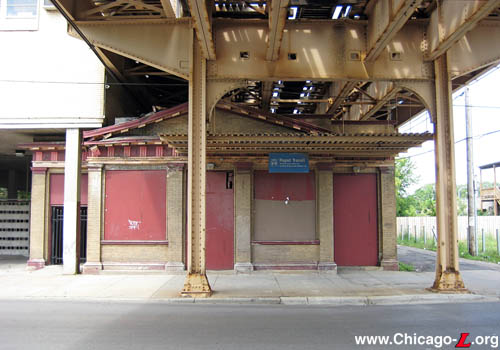
The Greek Revival-style Racine station is seen
boarded and unused, looking west on July 23, 2007. The station house has a high level of historical integrity, with few changes to its original architecture, though its maintenance has been minimal. Racine Shops is visible overhanging the south part of the building on the left. For a larger view, click here. (Photo by Graham Garfield) |
Racine
(6300S/1200W)
Racine Avenue and 63rd
Street, Englewood
Service
Notes:

|
Green Line:
Englewood branch
|
Quick Facts:
Address: 6314-16 S. Racine
Avenue
Established: February 25, 1907
Original Line: South Side Elevated Railroad, Englewood
branch
Previous Names: Center Street
|
Skip-Stop Type:
|

|
Station
|
Rebuilt: n/a
Status: Abandoned
History:
The Englewood branch of the South Side Rapid Transit began
construction in 1903. It opened in segments, beginning
November 3, 1905 with a shuttle from the main line at 58th Street to State Street. By
December 10 it was extended to Wentworth and Princeton (actually 61st Street) on January 11, 1906.
The next segment to Harvard
Street opened November 3 (the victim of a 226-day iron
workers' strike). Parnell and Halsted to the opened just
in time for last minute Christmas shopping on December 24. On February 25, 1907, the branch was extended to Center Street (now Racine Avenue), opening the station there. The rest of the line was opened to its
terminal at Loomis Blvd on July 13, 1907.
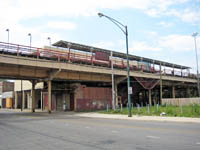
The Racine station is seen looking southwest on July 23, 2007. The removal of adjacent buildings provides an unusually good view of the complex, with the historic masonry station house is visible under the elevated structure and the original latticed platform canopy above. For a larger view, click here. (Photo by Graham Garfield) |
The facility at Racine consists of a
grade-level station house on the west side of the street, with stairs from the rear of the building leading to dual side boarding platforms at the elevated track level. The station was constructed in 1905-06, designed by architect
Earl Nielson, engineered by Charles Weston of the South Side
Elevated Railroad Company staff and built by the American
Bridge Company of New York.
The 40' by 40' station house is constructed of brick with copper and wood trim, stone sills
and limestone column bases executed in the Greek Revival
style. The most prominent feature of the front elevation is the triangular pediment above the front windows and doorway, which along with the articulated cornice, triglyphs and pilasters
made the building resemble a Doric temple. The front elevation has a center doorway for entry flanked by windows on each side. The building is flanked on each end by a side hallway, which leads from the front elevation to the rear, bypassing the interior fare control area. These could be used for auxiliary exiting or entry during pay-on-train periods. At the end of the station's service life, they were used for exiting only, regulated by high-barrier rotogates.
The interior was built with wooden floors and plaster walls and ceiling. Window and door frames are wooden. A vestibule was located at the front doorway. The rear doorways leading to the platforms are located in the northwest corner of the interior, while a restroom and porter's closet are located in the southwest corner. An ornate wooden ticket agent's booth was located in the middle of the north half of the interior.
From the
back of the station house, a stairway leads up to a mezzanine
level, then splits into two stairways to each of the
station's dual side platforms. The platforms are typical of
those on the Englewood branch, with wood decking on a steel
structure. The canopies are supported from the back of the
platform, with steel arched supports and latticework along
the back and a hipped corrugated metal roof. The original pipe railings were later replaced with simple angle iron. The original shepherd's crook light fixtures with incandescent bulbs were also later replaced with box-shaped sodium vapor lights.
On July 31, 1949, the CTA instituted its North-South
Route service revision, which included a number of station closures and the institution of A/B skip-stop service during heavy ridership periods. Under skip-stop service, trains on the mainline skipped alternating lower-ridership stations (designated as "A" or "B" stations) to provide faster service. All A trains served the Englewood branch, while all B trains served the Jackson Park branch. All Englewood stations were "A" stations, including Racine, effectively meaning services on the branches were all local. The South Side Elevated, including the branches, became part of the Green Line on February 21, 1993 when the through-routes of the former North-South
Route and West-South Route were swapped. In later years, the wood and metal parts of the station house, platform canopies, and railings were painted hues of dark red, salmon, and yellow-cream, as many stations in the 1970s and 80s were painted in various multi-toned schemes. A concession stand was also later built against the south wall of the interior, opposite the agent's booth.
On January 9, 1994, the Green Line closed for a two-year
rehabilitation. All stations on the line, including Racine, closed, but
unlike most other stations Racine did not reopen. During the
renovation, CTA decided to close some stations permanently to control
the costs of the renovation project, improve operations, and reduce
operating costs when the line reopened. Stations were identified for closure that were too close to other stations or, like Racine, had relatively low ridership with little immediate chance of improving use. The station closings were controversial in local communities, with residents and community leaders claiming that the CTA had reneged on its promise to reopen the stations and that the closures would hinder economic development in poorer communities.1 While the CTA still chose to keep the station closed, they did not demolish it. However, the choice to retain the facility had less to do with its future potential for reopening than with its status as a historic station per a memorandum of agreement between the CTA and the Illinois Historic Preservation Agency signed in the 1980s, which designated a number of stations as eligible for the National Register of Historic Places based on their architectural and/or historic merit.
The station house and platform have been altered little since closure, and are in fair but deteriorating condition due to a lack of regular maintenance. Eventually, the wood platform decking was removed both due to its deterioration and to discourage people, including CTA workers, from walking on the disused platform. At the same time, platform extensions installed during the early CTA era to extend the platform to 8-car length that had wood structural supports were also removed, leaving only the steel platform stringers from the original 1907 construction and a subsequent lengthening circa 1931. Some elements such as the pressed metal ornament in the station house cornice and pediment began to deteriorate by the 2010s, giving the headhouse an uncertain future. The left (south) half of the pressed metal pediment deteriorated to the point where it was removed by CTA forces in 2016 as a safety precaution; the right half of the pediment, which was better protected by the elevated track structure above, remained in place for a number of years but was removed sometime prior to 2022.
Racine is the last of the original
1906 Englewood branch stations left.
Proposals for Reopening
Local advocates argued that the closure of the Racine station caused economic repercussions for years after, with residents and businesses moving away.2 While there had been occasional discussion in the local community about the potential for reopening the shuttered Racine station in the decades since its closure, by 2021 those efforts become more formalized.
By spring 2021, a "Go Green On Racine" team -- a part of the R.A.G.E. (Residents Association of Greater Englewood) community organization, had been meeting with CTA leadership and federal officials to drum up interest in a project to reopen the stop, which they see as an integral part of their plan to revitalize the area.3 They also invited to fill out a Google form with questions about the closure's impact on their lives and whether they'd like to see the station reopened. The "Go Green" team received over 40 responses by April 2021, and nearly all of them are in favor of bringing the stop back.4 The "Go Green On Racine" advocates also asked neighbors to share their stories about their experiences using the Racine station years ago, and the current challenges posed by its closure, to create an organized, robust campaign around reviving the stop.5
In spring 2021, CTA estimated that renovations and work needed to reopen the station would cost $90-100 million. According to CTA, the station cannot be reopened in its present state and extensive updates would be required to place it back in service, including a new platform, stairs and elevator, all complicated by the need to preserve the historic building, resulting in the high cost estimate -- money the CTA said it does not have.6 Rep. Jesus Garcia (D-Illinois), one of the plan's biggest advocates and a member of the House Transportation and Infrastructure Committee, recommended $61 million in federal money to help at that time.7
After years of talks with CTA, city and federal officials, Englewood organizers circulated a petition in November 2022, hoping to put a referendum on the ballot for the February 28, 2023 election, asking residents if they want the station reopened. Though the referendum wouldn't force the CTA to do anything, residents hope an overwhelming show of support would put pressure on the city to reopen the stop.8 The effort was successful, and the issue was placed on the ballot.9 The question of reopening the Racine Green Line stop won resounding support from voters in the election, with 93 percent of 16th Ward voters endorsing a referendum about whether the city should reopen the station.10
In a letter to the editor printed in the Chicago Sun-Times on December 7, 2022, CTA President Dorval Carter stated that the CTA supports reopening the Racine station. Carter noted that, under his administration, "CTA views transit improvements as important investments not only in transportation, but, just as importantly, in equity." He stated that CTA was working very closely with local and federal officials to identify funding to advance planning for a reopened Racine Green Line station.11 By late 2022, the cost estimate for reopening the station had lowered to around $75 million, but it was noted that this figure was not final.12
In January 2023, it was announced that the CTA would receive $2 million to conduct a "feasibility study" on reopening the Racine station. The money will go toward planning and design analyses "to determine how a new station could be constructed to meet community needs, accessibility requirements and historic considerations," according to a released from the office of Rep. Bobby Rush, who helped secure the grant, in one of his final acts representing the 1st Congressional District before retiring. The $2 million "is an important first step" in reopening the station after nearly 30 years, as the CTA must complete preliminary designs and engineering to determine how the project can move forward.13
The study will also boost eligibility for additional funding for the project, according to the CTA. While total costs to overhaul the community-backed station are still too early to determine, the CTA returned to estimating the costs could be as high as $100 million.14
Advocates argue that restoring a critical city service like a Green Line station would capitalize on a boon of new projects sprouting up in Englewood. The Go Green Community Fresh Market, a nearly $5 million grocery store, opened in 2022 at 1207 W. 63rd St., bringing fresh, affordable options to the community. E.G. Woode, a collective of architects, designers, and entrepreneurs, opened a 4,000-square-foot retail space at 1122 W. 63rd St. in August 2022, giving entrepreneurs of color a space to do business. Local officials held a groundbreaking ceremony for the $14 million Englewood Connect development, a culinary hub and community "living room" that will repurpose a long-vacant firehouse, in September 2022.15
Alds. Stephanie Coleman (16th), David Moore (17th) and Jeanette Taylor (20th), among the five City Council members representing Englewood, have supported organizers' efforts around the Green Line station. Coleman, whose ward includes the site of the closed station, said she placed petitions at her community events to collect signatures and helped advise the group on how to structure the referendum. She also said she's pushing federal, state and city officials to back the effort, as well.16
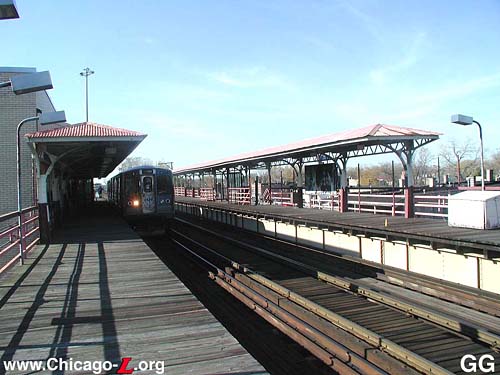
A view of the 1906-vintage
platforms and canopies in situ at the abandoned Racine/63,
looking west on the inbound platform with the
2001
Historic Station Tour
charter train in the station on November 4, 2001. Racine
Shops is on the left. For a larger view, click
here.
(Photo by Graham Garfield)
|

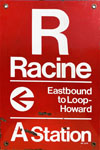
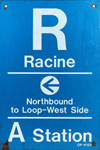
|
racine-P-8_KDRsignEB.jpg (248k)
racine-P-8_KDRsignNB.jpg (221k)
These "KDR"-style
symbol signs from the inbound platform at Racine are typical of this type and vintage -- large first letter of the station name with the full name under it; a "KDR arrow" pointing in the direction of travel with the direction and destination in the middle; and the skip-stop station type at the bottom -- but also provide an interesting study in variation over the life of the KDR signage standard.
The sign on the top was the original implementation of KDR platform signage at Racine, and dates from 1979. The kerning (letter spacing) is tighter, reflecting Modernist design aesthetics of the 1960s and 70s. The station name is larger overall and relative to the "R". The direction provided reflects the actual cardinal direction trains are going at Racine (eastward, even though their overall direction over the route as a whole is northbound; it also give Howard as the ultimate destination, reflecting the Englewood-Howard service pattern of the time). And the color is also standard -- in the KDR signage system, red backgrounds were for 'A' stations.
The sign on the bottom is a replacement sign installed in 1993 when the north-south and west-south through-routes were swapped, resulting in the Englewood service where Racine was located being paired with Lake service (creating the new Green Line) rather than Howard service as before. This lasted only one year before the line was closed for renovation. When the sign was updated, the most obvious changes was the blue color, previously used for 'AB' or All-Stop stations under the KDR standard, even though Racine was still an 'A' station -- this was because, beginning in the early 1990s, CTA dropped the color-coding of station signage and made all station name and symbol signs blue. The letter kerning is also generally looser than the original 1970s version, the station name is much smaller than before, and the arrow and directional information is stacked rather than side-by-side (an arrangement more typical of, though not exclusive to, the narrower 8-8.5" wide version of KDR symbol signs). (Signs courtesy of Bill Wulfert) |
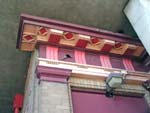
|
racineDetail.jpg (176k)
The close-up of the entablature and cornice on the top of the Racine station front elevation, seen on November 4, 2001, shows the classic Greek Revival details included in the station's design. The narrow architrave "supporting" the pilasters, painted yellow-cream, gives way to the dark red-painted frieze punctuated by salmon-colored triglyphs. As is typical in Greek Revival architecture, this is topped by a cornice, in this case one that projects out with a shallow eave. The eave's ornamentation consists of an inset diamond pattern alternated with a rectangular block called a mutule immediately over/aligned with each triglyph, decorated on its under-surface with six rows of six guttae, descending cylindrical, peg-like projections. These details make the Racine station's architecture a classic example of this style of design. (Photo by Graham Garfield) |
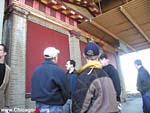
|
tour01@Racine-63rd02.jpg
(128k)
The Classical Revival architecture of the Racine station
provides a picturesque backdrop and interesting subject for
2001 Historic Station Tour
guide Graham Garfield on November 4, 2001.
(Photo by Tony Coppoletta)
|

|
tour01@Racine-63rd03.jpg
(131k)
Racine station provided a number of interesting subjects for
the 2001 Historic Station
Tour, including the abandoned Classical Revival station
house at street level, the old steel latticed platform
canopies, and the modern Racine Shops next door, all visible
in this photo looking northwest from the east side of South
Racine Avenue on November 4, 2001. (Photo by
Graham Garfield)
|

|
tour01@Racine-63rd04.jpg
(135k)
Keith Letsche says a few words as the tour members return to
the platform from street level for a final look around
before reboarding the train during the 2001
Historic Station Tour on November 4,
2001. (Photo by Graham Garfield)
|
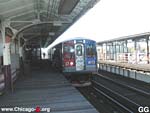
|
tour01@Racine-63rd05.jpg
(110k)
2001 Historic Station Tour
charter train car 2479 has boarded its passengers and it
ready to head to its next destination on November 4, 2001.
The platforms at the closed Racine station, though looking a
bit rough with peeling paint and little cleaning, are
actually in fairly good shape. There is a small bit
rust-jacking on some of the canopy columns,
however. (Photo by Graham
Garfield)
|
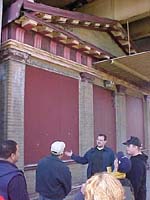
|
tour01@Racine-63rd07.jpg
(33k)
2001 Historic Station Tour
guide Graham Garfield describes the architecture and history
of the closed Racine station on November 4,
2001.
(Photo by Frank Hashimoto)
|
 |
racine03.jpg (186k)
The underside of the canopy on the outbound Racine platform is seen looking east on March 2, 2003. This view shows the canopy's hipped roof design, with curved brackets supporting the canopy from a row of columns along the back. A latticed band along the back under the canopy is largely decorative. Aside from different paint and lights, the canopy is largely as-built. The original railings were replaced with angle iron at some undetermined date. (Photo by Graham Garfield) |
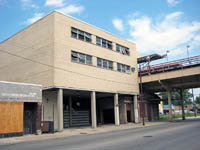 |
racineshops01.jpg (172k)
Racine Shops is seen looking northwest on Racine Avenue on July 23, 2007. The whole shop building is elevated on columns, which puts its main floor at the level of the elevated train yard west of the building and allows it to clear the roof of the Racine station house, which extends out from under the elevated structure. The overlap between the two can be seen in the middle of the photo, and the station canopy up above is visible projected out from beyond the shop building. (Photo by Graham Garfield) |
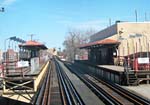 |
racine04.jpg (127k)
The Racine station platform is seen looking east on March 27, 2011 from the rear of IRM's 2011 Snowflake Special charter train. The platforms and canopies are structurally intact, but in the absence of regular maintenance the platform decking has deteriorated over the years. The signs on the end of the platforms reminds train operators that Racine is not a passenger stop, and informs all personnel that no one should walk on the platforms. (Photo by Dennis Herbuth) |

|

|
Notes:
1. Wu, Olivia. "Coalition Protests Green Line Closings". Chicago Tribune, 28 February 1996.
2. Golden, Jamie Nesbitt. "Remember The Racine Green Line Station In Englewood? 'Go Green On Racine' Wants To Document Your Memories." Block Club Chicago, Apr 26, 2021.
3. Ibid.
4. Ibid.
5. Ibid.
6. Rush, Mariah. "Decades after Racine Green Line station closed, Englewood activists renew push to reopen it." Chicago Sun-Times, Nov 24, 2022.
7. Golden, ibid.
8. Rush, ibid.
9. Reed, Atavia and Jamie Nesbitt Golden. "30 Years Ago, Englewood's Racine Green Line Station Shut Down. Now, Neighbors Are Ramping Up Fight To Bring It Back." Block Club Chicago, Dec 9, 2022.
10. Reed, Atavia. "Englewood Voters Overwhelmingly Support Referendum To Reopen Racine Green Line Station." Block Club Chicago, Mar 2, 2023.
11. Carter, Dorval R. "Letters to the Editor - CTA supports reopening Racine station on Green Line." Chicago Sun-Times, Dec 7, 2022.
12. Reed and Golden, ibid.
13. Reed, Atavia. "Will The City Reopen Englewood's Long-Closed Racine 'L' Stop? CTA Gets $2 Million To Study The Plan." Block Club Chicago, Jan 4, 2023.
14. Ibid.
15. Reed and Golden, ibid.
16. Ibid.
















